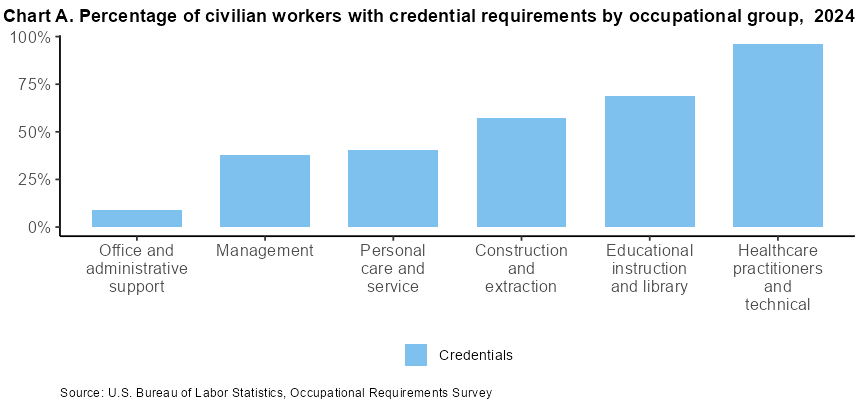An official website of the United States government
 United States Department of Labor
United States Department of Labor
The Occupational Requirements Survey (ORS) publishes job-related information on physical demands; environmental conditions; education, training, and experience; as well as cognitive and mental requirements. The job requirements reflect those necessary for workers to perform critical tasks in support of the critical job functions, and not the capabilities of individual workers.
Credentials include training time required as a condition of hiring, which often results in certifications, licenses, or educational certificates and are part of the education, training, and experience requirements.
The published estimates reflect the percentage of workers with credential requirements and the time necessary to obtain them.
Credential requirements include:
Licenses which are issued by a government agency and constitute a legal authority to perform a specific occupation. Similar to a certification, a license expires if not renewed.
Certifications which are issued by a certification body, industry association, or professional association and acknowledge that occupation specific skills and abilities exist. Certifications expire if not renewed.
Educational certificates which are issued by an educational institution (or a training provider) and certify that an occupation specific program of study was completed. Educational certificates typically do not expire.
Apprenticeships, vocational training, non-credit courses, and credit courses that do not result in a degree are included in credential requirements. When workers are expected to obtain credentials to perform critical job tasks, these requirements are included in estimates.
Not all credentials are included in the ORS estimates. Instances where:
credentials are desirable but are not required,
credentials are part of the hiring criteria but are not associated with any critical job tasks, and
certificates of attendance or participation for training that is not vocationally relevant are not included in credential requirement estimates.
In 2024, 40.4 percent of civilian workers were required to have a credential.
Among published occupational groups, credential requirements ranged from 8.8 percent of office and administrative support workers to 95.9 percent of healthcare practitioners and technical workers. (See Chart A.)

Additional resources:
Articles:
Minds at work: what’s required according to the Occupational Requirements Survey (PDF)
A look at teachers’ job requirements, employer costs, and benefits (PDF)
Occupational Requirements Survey: Third wave testing report (PDF)
Occupational Requirements Survey: results from a job observation pilot test
The Occupational Requirements Survey: estimates from preproduction testing
For additional information on occupational requirements see the ORS homepage or download the ORS complete dataset to explore the latest estimates.